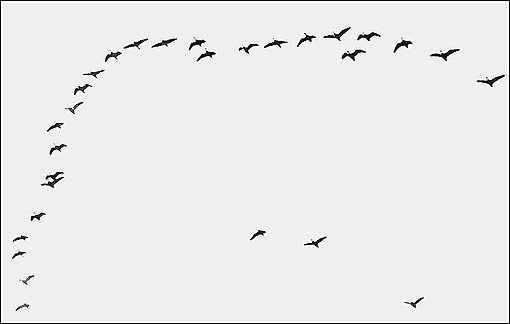or air pressure as in the closely formed flocks during the day. That countless numbers of birds migrate at night has been abundantly demonstrated and requires no proof.
The Protective Form of Certain Flight Formations
The flight formations of birds which fly in flocks vary greatly with different species, so varying is it that in many cases it is an identifying characteristic. Many small land birds fly in very compact groups, examples of which are the various species of blackbirds, grackels, cedar birds, finches, etc. Many water birds fly in compact flocks. Moreover, for many species there seems to be some general law regarding the size of the bird and the distance apart of the different individuals of the flock.
Probable Explanation of the Echelon Formation
The most distinctive formation is the echelon arrangement of flight and deserves special attention. Many of the larger water birds such as geese, many species of ducks, flamingoes, etc., practise this method of flight. The formation, according to one explanation, owes its origin to the fact that such an arrangement prevents swirls in the air produced by the wings of one bird from interfering with the next bird following. This may be true to some extent, but the explanation which the author holds as far more likely is that the formation is chiefly, if not wholly, a protective arrangement, and is, in fact, the only one in which the individual birds of the flock, if they are of considerable size, can see both forward and to the side at the same time, as demonstrated by the
Fig. 7. Flock of Blue Geese in Echelon Formation, photographed by the Rev. H. K. Job. As in Fig. 6, for each goose, the view is unobstructed in front and at right angles to the line of flight.


